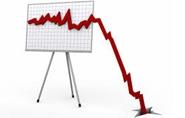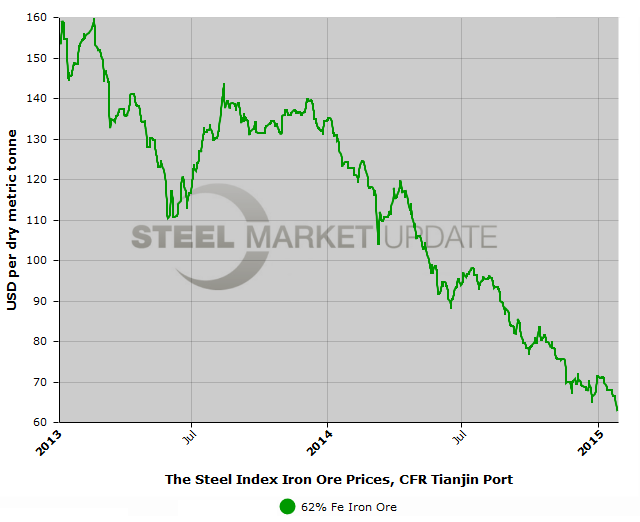Steel Products Prices North America

Iron Ore Slide Continues: Reaches $1 for 1% Fe Value
Written by John Packard
January 27, 2015
Spot iron ore prices in China, which saw a small spike in prices right around the beginning of the New Year, have since continued their slide with 62% Fe fines being reported at $62.8 per dry metric ton (dmt) earlier today by The Steel Index (CFR Tianjin). Iron ore is down 11 percent since the beginning of the New Year.
The latest prices represent the lowest pricing seen since May 2009 at the height of the Great Recession.
Our iron ore trading source in Asia has been telling Steel Market Update for some time that iron ore should reach $60 per dry metric ton on 62% Fe fines very soon. In an email received earlier today we were told:
Quite a few analysts or Bulletins expect dramatic cut in over capacity in the Steel Sector in China in 2015, but from what we know, there will be only around 15 million tons of cutbacks John and this should leave Ore prices at USD50-60/mt throughout 2015. We have right now a USD1.00 to Fe 1% value.

John Packard
Read more from John PackardLatest in Steel Products Prices North America

Nucor slows HRC price climb with $5/ton increase
After eight weeks of double-digit price increases on hot-rolled (HR) coil, Nucor slowed the price rise this week with an increase of $5 per short ton.

Domestic CRC prices surge ahead of imports
The price spread between stateside-produced CR and imports reached its widest margin in over a year.

Evraz raises plate prices $160/ton
Evraz North America (NA) has followed Nucor and SSAB with a plate price increase of its own: up $160 per short ton (st). The increase was effective immediately for all new orders of carbon, high-strength low-alloy, and normalized and quenched-and-tempered plate products, as well as for hot-rolled coil, the steelmaker said in a letter to […]

Nucor lifts HR coil to $820/ton
Nucor has increased its consumer spot price (CSP) for hot-rolled (HR) coil for a fourth consecutive week.

Nucor pushes HR spot price to $790/ton
Nucor increased its consumer spot price (CSP) for hot-rolled (HR) coil to $790 per short ton (st) on Monday, Feb. 10 – a $15/st bump vs. last week. The Charlotte, N.C.-based company has raised its weekly CSP by $40/st over the past three weeks after maintaining tags at $750/st since Nov. 12, according to SMU’s […]

